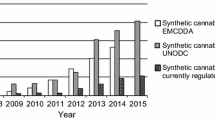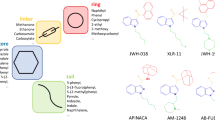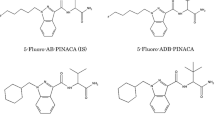Abstract
In this study, seven commercial “spice-like” products available on the German market were analyzed. They all contained significant amounts of synthetic cannabinoids and had distinctly different compositions of these adulterants. All synthetic cannabinoids were extracted and purified by different chromatographic techniques from the respective product. The structures of all compounds were elucidated by nuclear magnetic resonance spectroscopy and further characterized by mass spectrometry (MS) and ultraviolet and infrared spectroscopy to generate a full data set of each compound. Altogether, eight compounds were identified, and one deuterium-labeled cannabinoid was used as internal standard. Four products contained only one individual compound, while three products contained mixtures of two compounds. Among the eight isolated compounds, six were already known from recent publications (JWH-081, JWH-210, JWH-122, AM2201, RCS-4, and JWH-203), but the published data were not always complete. In addition, two unknown compounds (AM2201-pMe, RCS-4-(N-Me)) were isolated. Overall, compounds from three distinct classes of synthetic cannabinoids could be identified, characterized, and compared. The MS data of the different subclasses allowed the postulation of some general key fragmentations to distinguish between these subclasses. In addition, we established a general method using an isotopically labeled internal standard (JWH-018-D3) to quantify synthetic cannabinoids in herbal mixtures. The total content of the synthetic cannabinoids ranged from 77.5 to 202 mg/g, while individual compounds were detected from 19.3 to 202 mg/g in these products. The spectroscopic data for all compounds mentioned here were collected and added en bloc as Electronic supplementary material to this manuscript.

Analysis of synthetic cannabinoids in herbal smoking blends





Similar content being viewed by others
References
Auwärter V, Dresen S, Weinmann W, Müller M, Pütz M, Ferreirós N (2009) Spice and other herbal blends: harmless incense or cannabinoid designer drugs? J Mass Spectrom 45. doi:10.1002/jms.1558, Published Online: Feb. 2 2009
http://www.welt.de/wissenschaft/article2881866/Erstmals-Wirkstoff-von-Mode-Droge-Spice-belegt.htmL; Accessed 2 Mar 2012
European Monitoring Centre for Drugs and Drug Addiction (EMCDDA) (2011) Annual report on the state of the drugs problem in Europe, Lisbon, November. http://www.emcdda.europa.eu/attachements.cfm/att_143743_EN_EMCDDA_AR2011_EN.pdf; Accessed 2 Mar 2012
Bundesgesetz über den Schutz vor Gesundheitsgefahren im Zusammenhang mit Neuen Psychoaktiven Substanzen (Neue-Psychoaktive-Substanzen-Gesetz, NPSG) (2012) http://www.parlament.gv.at/PAKT/VHG/XXIV/I/I_01518/fname_235558.pdf; Accessed 2 Mar 2012
Advisory Council on the Misuse of Drugs (ACMD) Consideration of the major cannabinoid agonists. 16th July, 2009. http://www.namsdl.org/documents/ACMDMajorCannabinoidReport.pdf; Accessed 2 Mar 2012
Pharmazeutische Zeitung online, Synthetische Drogen bereiten weiter Probleme (2011) http://www.pharmastudi.de/index.php?id=40025; Accessed 2 Mar 2012
United Nations Office on Drugs and Crime, Synthetic cannabinoids in herbal products (April 2011) http://www.unodc.org/documents/scientific/Synthetic_Cannabinoids.pdf; Accessed 2 Mar 2012
United States Drug Enforcement Authorities http://www.justice.gov/dea/pubs/pressrel/pr030111.htmL; Accessed 2 Mar 2012
Ernst L, Schiebel H-M, Theuring C, Lindigkeit R, Beuerle T (2011) Identification and characterization of JWH-122 used as new ingredient in ‘spice-like’ herbal incenses. Forensic Sci Int 208:e31–e35
Uchiyama N, Kawamura M, Kikura-Hanajiri R, Goda Y (2011) Identification and quantitation of two cannabimimetic phenylacetylindoles JWH-251 and JWH-250, and four cannabimimetic naphthoylindoles JWH-081, JWH-015, JWH-200, and JWH-073 as designer drugs in illegal products. Forensic Toxicol 29:25–37
Nakajima J, Takahashi M, Seto T, Kanai C, Suzuki J, Yoshida M, Hamano T (2011) Identification and quantitation of two benzoylindoles AM-694 and (4-methoxyphenyl)(1-pentyl-1H-indol-3-yl)methanone, and three cannabimimetic naphthoylindoles JWH-210, JWH-122, and JWH-019 as adulterants in illegal products obtained via the Internet. Forensic Toxicol 29:95–110
Nakajima J, Takahashi M, Nonaka R, Seto T, Suzuki J, Yoshida M, Kanai C, Hamano T (2011) Identification and quantitation of a benzoylindole (2-methoxyphenyl)(1-pentyl-1H-indol-3-yl)methanone and a naphthoylindole 1-(5-fluoropentyl-1H-indol-3-yl)-(naphthalene-1-yl)methanone (AM-2201) found in illegal products obtained via the Internet and their cannabimimetic effects evaluated by in vitro [35S]GTPγS binding assays. Forensic Toxicol 29:132–141
Bononi M, Belgi P, Tateo F (2011) Analytical data for identification of the cannabimimetic phenylacetylindole JWH-203. J Anal Toxicol 35:360–363
Ernst L, Schulz P (1992) 13C and 1H NMR chemical shift assignments of 1- and 2-alkylnaphthalenes (R = Me, Et, i-Pr, t-Bu) and determination of substituent effects on 13C and 1H chemical shifts. Magn Reson Chem 30:73–76
Ernst L (1975) 13C-NMR-spektroskopie an polycyclischen Aromaten, I. Naphthole, napthalindiole und monomethoxynaphthaline. Vollständige Zuordnung der 13C-NMR-Spektren und Untersuchung der Substituenteneffekte auf die chemischen Verschiebungen. Chem Ber 108:2030–2039
Lindigkeit R, Boehme A, Eiserloh I, Luebbecke M, Wiggermann M, Ernst L, Beuerle T (2009) Spice: a never ending story? Forensic Sci Int 191:58–63
Aung MM, Griffin G, Huffman JW, Wu M-J, Keel C, Yang C, Showalte VM, Abood ME, Martin BR (2000) Influence of the N-1 alkyl chain length of cannabimimetic indoles upon CB1 and CB2 receptor binding. Drug Alcohol Depend 60:133–140
Hopfgartner G, Varesio E, Tschäppät V, Grivet C, Bourgogne E, Leuthold LA (2004) Triple quadrupole linear ion trap mass spectrometer for the analysis of small molecules and macromolecules. J Mass Spectrom 39:845–855
Olsen JV, Macek B, Lange O, Makarov A, Horning S, Mann M (2007) Higher-energy C-trap dissociation for peptide modification analysis. Nat Methods 4:709–712
Dresen S, Ferreirós N, Pütz M, Westphal F, Zimmermann R, Auwärter V (2010) Monitoring of herbal mixtures potentially containing synthetic cannabinoids as psychoactive compounds. J Mass Spectrom 45:1186–1194
Author information
Authors and Affiliations
Corresponding author
Electronic supplementary material
Below is the link to the electronic supplementary material.
ESM 1
(PDF 2.15 mb)
Rights and permissions
About this article
Cite this article
Simolka, K., Lindigkeit, R., Schiebel, HM. et al. Analysis of synthetic cannabinoids in “spice-like” herbal highs: snapshot of the German market in summer 2011. Anal Bioanal Chem 404, 157–171 (2012). https://doi.org/10.1007/s00216-012-6122-4
Received:
Revised:
Accepted:
Published:
Issue Date:
DOI: https://doi.org/10.1007/s00216-012-6122-4




